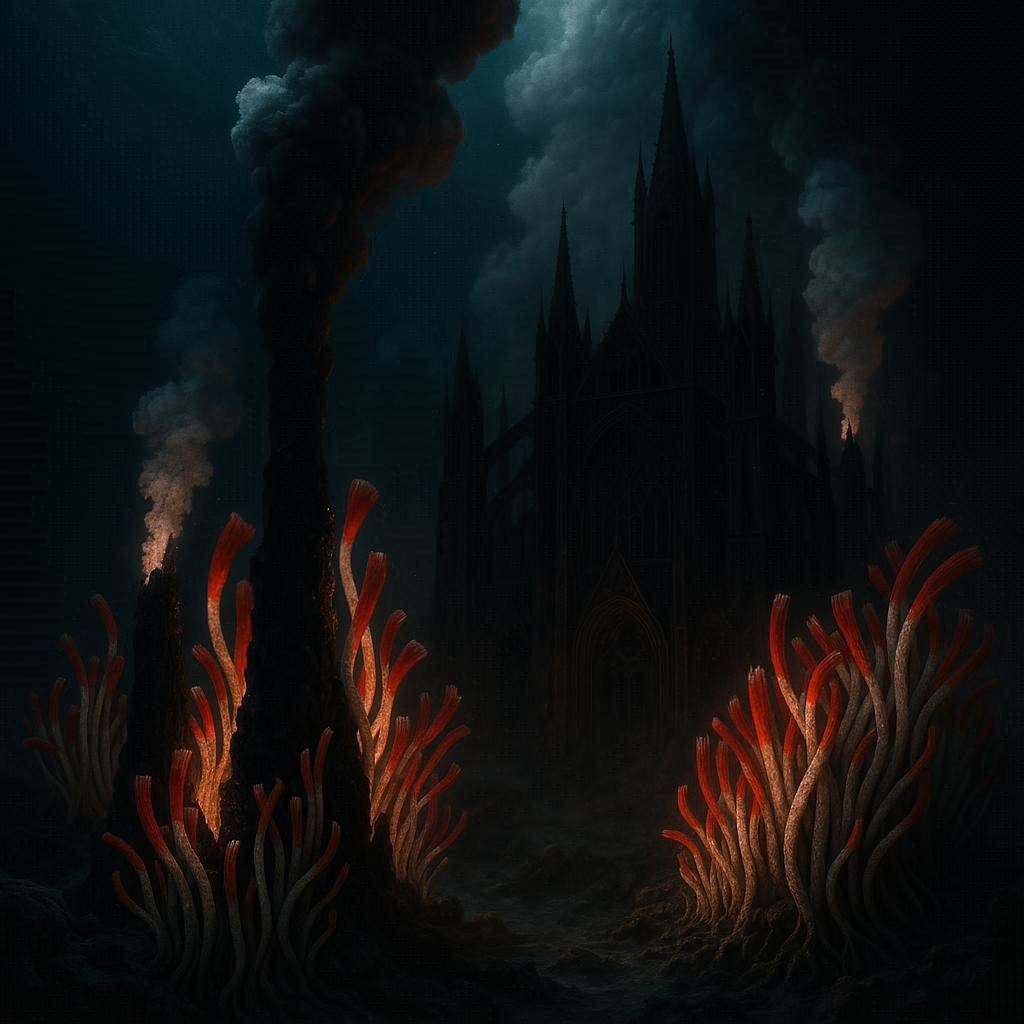Life on Earth is often described as fragile, delicate, and dependent on a narrow balance of conditions. We tend to think of life as requiring mild climates, fertile soil, and temperate waters. Yet the reality is far more astonishing. Life thrives not only in lush forests and calm seas but also in the most hostile corners of our planet—places where the human imagination can hardly conceive survival. From scalding hot springs to frozen deserts, from crushing ocean trenches to toxic pools of acid, organisms known as extremophiles have evolved remarkable strategies to endure. They challenge our very definition of what it means to be alive, forcing us to expand our vision of biology and even reconsider the possibility of life beyond Earth.
The Boiling Breath of Hydrothermal Vents
Deep beneath the ocean’s surface, in places where sunlight has never penetrated, cracks in Earth’s crust release jets of superheated, mineral-rich water. These hydrothermal vents, discovered only in 1977, spew fluids that can reach temperatures above 400°C, hot enough to melt lead. The pressure at these depths is immense—hundreds of times greater than at the surface—yet it is here that life forms flourish in great abundance.
Tube worms, some stretching meters long, cluster around these vents. They have no mouths and no digestive tracts. Instead, they rely on symbiotic bacteria that convert chemicals like hydrogen sulfide into energy through chemosynthesis. Shrimp with light-sensitive organs, giant clams, and colonies of microbes form ecosystems that rival coral reefs in density and diversity. These communities do not depend on sunlight but on the Earth’s inner heat, living proof that life can thrive in worlds utterly unlike our own.
The discovery of vent ecosystems revolutionized biology. Before them, scientists believed sunlight was essential for complex life. Hydrothermal vents revealed that chemical energy, drawn from the planet’s interior, could sustain entire food webs. This insight extended the search for life beyond Earth, suggesting that moons like Europa and Enceladus—icy worlds with subsurface oceans and likely hydrothermal activity—may harbor their own alien biospheres.
The Salt-Crystal Deserts
Across the globe, salt flats and hypersaline lakes present another extreme. The Dead Sea, the Great Salt Lake, and Ethiopia’s Danakil Depression contain salt concentrations that can exceed ten times that of the ocean. To most organisms, such salinity is lethal, drawing water out of cells until they collapse. Yet halophiles—“salt lovers”—not only endure these conditions but depend on them.
These microorganisms have evolved specialized proteins and membranes that resist the dehydrating pull of salt. Some produce vivid pigments—reds, oranges, and purples—that turn salt ponds into surreal landscapes of color. These pigments also protect cells from intense solar radiation, allowing survival under a double assault of salt and light.
In the Danakil Depression, one of the hottest and most inhospitable places on Earth, life persists in brines of salt, sulfur, and toxic minerals. Here, temperatures often soar above 45°C and water bodies shimmer in neon shades, a reminder that life not only survives but paints beauty into the harshest corners of our world.
The Scalding Embrace of Hot Springs
Yellowstone National Park in the United States, Iceland’s geothermal pools, and Kamchatka’s steaming fields offer another glimpse of resilience. In these boiling waters, where temperatures can surpass 90°C, thermophiles make their home. To most organisms, proteins unravel and DNA breaks apart at such heat. But thermophiles possess heat-stable enzymes and protective adaptations that keep their molecular machinery intact.
The microbes of Yellowstone’s Grand Prismatic Spring paint the pool with vibrant rings of orange, green, and yellow. Each band marks a community adapted to a specific temperature and chemical gradient. These organisms not only survive extreme heat but often require it; they cannot grow at normal temperatures. Their enzymes have become indispensable in human science and industry, powering DNA replication in laboratories worldwide and enabling processes that would otherwise be impossible.
Hot springs reveal life’s ingenuity in transforming peril into necessity. They also demonstrate how deeply human progress depends on extremophiles. Without them, modern genetics and biotechnology would not exist as we know them.
Frozen Frontiers of Survival
At the opposite end of the spectrum lies cold so intense it halts water in its tracks. Antarctica’s Dry Valleys, the Arctic tundra, and glaciers across the world represent some of the coldest, driest, and most barren environments on Earth. Yet even here, life clings on.
Psychrophiles—“cold lovers”—have evolved enzymes that remain flexible in freezing conditions, where most proteins would lock rigid and cease functioning. They alter their cell membranes to remain fluid and produce antifreeze proteins that prevent deadly ice crystals from forming inside them. Beneath thick layers of ice, microbial communities persist in liquid brines sealed off for millennia.
In Lake Vostok, buried beneath nearly four kilometers of Antarctic ice, scientists have detected signs of microbial life. These organisms have lived in isolation for millions of years, hidden in an alien darkness. The survival of microbes in such places suggests that frozen moons in our solar system may also harbor life beneath their icy shells. Earth’s frozen extremes become a rehearsal stage for exploring cosmic frontiers.
The Acid Pools of Hell
Acid is usually synonymous with destruction. It eats away at metal, corrodes stone, and burns human skin. Yet in places like Spain’s Río Tinto or Indonesia’s sulfuric crater lakes, acidophiles thrive in waters with a pH approaching zero—conditions more hostile than battery acid.
These microbes survive by pumping out excess hydrogen ions and protecting their internal chemistry from corrosive surroundings. Some feed on metals dissolved in the acid, producing energy by oxidizing iron or sulfur. The striking red waters of the Río Tinto, stained by iron, conceal a rich microbial ecosystem.
Such environments provide crucial insights into early Earth, which was once far more acidic than today. They also offer models for the types of life that might survive on Mars, where acidic minerals litter the surface. Life in acid tells us that even chemical extremes do not close the door on biology.
The Crushing Depths of the Abyss
The ocean floor plunges into trenches so deep that Mount Everest could fit within them and still remain submerged. In the Mariana Trench, nearly 11 kilometers down, the pressure is over a thousand times greater than at sea level. Human bodies would be crushed instantly. Yet piezophiles—organisms adapted to high pressure—flourish here.
Microbes survive by modifying their cell membranes and proteins to remain functional under compression that would paralyze ordinary life. Giant amphipods and snailfish patrol the depths, their bodies adapted to withstand the crushing environment. Bioluminescent creatures glow in the blackness, signaling, hunting, and mating with living light.
The abyss reminds us that pressure, like heat, is not universally hostile. Instead, it is simply another condition to which life can adapt. The presence of thriving ecosystems in the world’s deepest waters challenges any assumption that limits life to “comfortable” conditions.
The Burning Sands of Deserts
Deserts represent another extreme—heat by day, cold by night, and water so scarce that survival seems impossible. Yet desert crusts, formed of microbial communities, anchor ecosystems in places like the Sahara and Atacama. These microbes endure desiccation by entering dormant states, reawakening with the rare arrival of rain or mist. Some even harvest moisture directly from the air.
The Atacama Desert in Chile is one of the driest places on Earth, with regions that go decades without rainfall. Yet microbial life persists within rocks, shielded from ultraviolet radiation and nourished by trace minerals. These endolithic communities, invisible to the naked eye, represent some of the most resilient life forms on the planet.
Deserts illustrate life’s ability to endure not only extremes of heat and dryness but also extremes of absence—the absence of the very thing life is thought to require most: water.
The Radioactive Frontiers
Radiation is perhaps one of the most lethal forces known to biology. It shreds DNA, destroys proteins, and causes mutations that accumulate until life collapses. Yet organisms like Deinococcus radiodurans laugh in the face of radiation. Nicknamed “Conan the Bacterium,” it can survive doses of radiation thousands of times higher than what would kill a human.
It achieves this by possessing extraordinary DNA repair mechanisms, rapidly stitching its genetic code back together after devastation. It can also endure desiccation, cold, and toxic chemicals. D. radiodurans has been found thriving in nuclear reactors and laboratories.
The existence of radiation-resistant life shows that even in the aftermath of nuclear catastrophe, life finds a way. It speaks of resilience at the molecular level, of evolution sculpting survival out of forces that seem designed for annihilation.
The Interplay of Extremes
In many places, extremes do not occur in isolation but combine into multi-layered challenges. In the Danakil Depression, organisms endure a triple assault of heat, salinity, and acidity. In Antarctic lakes, microbes endure cold, pressure, and nutrient starvation. In deserts, they endure dryness, radiation, and fluctuating temperatures.
These overlapping stresses push life to the very edge of possibility. They also reveal the incredible plasticity of biology—the ability of organisms to not just adapt to one hardship but to several at once. Such resilience suggests that life is not rare but inevitable, ready to spring forth wherever conditions allow even the smallest chance.
Rethinking Life Beyond Earth
The study of extremophiles reshapes humanity’s search for extraterrestrial life. If organisms can thrive in boiling acid, in frozen darkness, or under crushing pressure, then why not beneath the ice of Europa, within the methane lakes of Titan, or in the dust storms of Mars? Each extreme environment on Earth becomes a model for what may exist elsewhere.
The lesson is profound: Earth is not the sole cradle of possibility but merely one example of life’s ingenuity. Our planet’s most extreme habitats teach us that life is less about comfort and more about adaptability. Where there is energy, chemistry, and persistence, life finds a foothold.
The Poetry of Survival
What emerges from these extremes is not merely scientific wonder but also an emotional truth. Life is not fragile—it is tenacious. It clings to boiling vents, freezes into glaciers, seeps into salt crystals, and glows in the abyss. It laughs at boundaries, rewrites definitions, and astonishes with creativity.
In the story of extremophiles, we find a reflection of our own struggles. Just as microbes endure pressure, heat, and darkness, so too does humanity endure challenges, wars, and crises. Life at the edge becomes a metaphor for persistence against all odds.
The most extreme places where life thrives remind us that survival is not about ease but about adaptation, not about comfort but about resilience. They whisper that life, in all its forms, is an unstoppable force—a flame that burns even in the coldest night, a seed that sprouts even in the hardest stone.
And as long as life endures in the most unforgiving corners of Earth, hope endures too—that wherever the universe offers the faintest chance, life will rise to meet it.






